|

On eBay Now...
1865 President Abraham Lincoln Color 10x12 Pencil Etching Kimmel & Forster N.Y. For Sale

When you click on links to various merchants on this site and make a purchase, this can result in this site earning a commission. Affiliate programs and affiliations include, but are not limited to, the eBay Partner Network.

1865 President Abraham Lincoln Color 10x12 Pencil Etching Kimmel & Forster N.Y.:
$999.00
This 1865 President Abraham Lincoln 10x12 Color Pencil Etching Kimmel & Forster N.Y. is the exact item you will receive and has been certified Authentic by REM Fine Collectibles.
Christopher Kimmel worked as an engraver, lithographer, and printer in New York City with three different partners: Samuel Capewell (1852-1862), Thomas Forster (1865-1870), and Henry E. F. Voigt (1871-1877).
In American Engravers Upon Copper and Steel (1907), David McNeely Stauffer incorrectly identifies a P.K. Kimmel as a “New York engraver of vignettes and portraits, working about 1850, and was later a member of the engraving firm of Capewell & Kimmell [sic], of the same city. There was also an engraving firm of Kimmel & Foster.” This appears to merge information about New York engraver Frederick K. Kimmel and Christopher Kimmel.
Chr. Kimmel & Co.: An American engraving firm, based in New York, Chr. Kimmel & Co., created original engravings for various mid 19th century publications such as, Godey's Lady's Book published by Louis A. Godey in Philadelphia from 1830 to 1898, and Frank Leslie's Ladies' Gazette. * G. B. Opitz, Mantle Fielding’s Dictionary of American Painters, Sculptors and Engravers, Poughkeepsie, New York, Apollo Books, 1987, p. 488, states that P. K. Kimmel was an engraver of vignettes and portraits working in New York around 1850 and that he later became a member of the New York engraving firm of Capewell & Kimmel which in time would become the firm of Chr. Kimmel & Company. Fielding also suggests that he may also be the same German / American engraver and lithographer, Christopher Kimmel born in 1930 who was also a member of the Kimmel & Forster firm. So, it is very likely that Kimmel's first name is Christopher.
Timeline1852-1856: Capewell & Kimmel, Engravers, 208 Broadway1857-1858: Capewell & Kimmel, engravers, 356 Broadway1859-1862: Capewell & Kimmel, engravers, 217 Canal1863: Christopher Kimmel, engraver, 217 Canal1864: Christopher Kimmel, printer, 256 Canal1865-1870: Kimmel & Forster, engravers, lithographers, printers, and colorers, 254 and 256 Canal1871-1877: Kimmel & Voigt, engravers, lithographers, printers, and print colorers, 256 Canal1878-: Kimmel & Voigt (George R. Kimmel & Henry E. F. Voigt), 256 Canal, 242 Canal
Abraham Lincoln (/ˈlɪŋkən/ LINK-ən; February 12, 1809 – April 15, 1865) was an American lawyer, politician, and statesman who served as the 16th president of the United States from 1861 until his assassination in 1865. Lincoln led the Union through the American Civil War to defend the nation as a constitutional union and succeeded in abolishing slavery, bolstering the federal government, and modernizing the U.S. economy.
Lincoln was born into poverty in a log cabin in Kentucky and was raised on the frontier, primarily in Indiana. He was self-educated and became a lawyer, Whig Party leader, Illinois state legislator, and U.S. congressman from Illinois. In 1849, he returned to his successful law practice in Springfield, Illinois. In 1854, he was angered by the Kansas–Nebraska Act, which opened the territories to slavery, and he re-entered politics. He soon became a leader of the new Republican Party. He reached a national audience in the 1858 Senate campaign debates against Stephen A. Douglas.
Lincoln ran for president in 1860, sweeping the North to gain victory. Pro-slavery elements in the South viewed his election as a threat to slavery, and Southern states began seceding from the nation. During this time, the newly formed Confederate States of America began seizing federal military bases in the South. Just over one month after Lincoln assumed the presidency, the Confederate States attacked Fort Sumter, a U.S. fort in South Carolina. Following the bombardment, Lincoln mobilized forces to suppress the rebellion and restore the union.
Lincoln, a moderate Republican, had to navigate a contentious array of factions with friends and opponents from both the Democratic and Republican parties. His allies, the War Democrats and the Radical Republicans, demanded harsh treatment of the Southern Confederates. Anti-war Democrats (called "Copperheads") despised Lincoln, and irreconcilable pro-Confederate elements plotted his assassination. He managed the factions by exploiting their mutual enmity, carefully distributing political patronage, and by appealing to the American people. His Gettysburg Address came to be seen as one of the greatest and most influential statements of American national purpose. Lincoln closely supervised the strategy and tactics in the war effort, including the selection of generals, and implemented a naval blockade of the South's trade. He suspended habeas corpus in Maryland and elsewhere, and averted British intervention by defusing the Trent Affair.
In 1863, he issued the Emancipation Proclamation, which declared the slaves in the states "in rebellion" to be free. It also directed the Army and Navy to "recognize and maintain the freedom of such persons" and to receive them "into the armed service of the United States." Lincoln also pressured border states to outlaw slavery, and he promoted the Thirteenth Amendment to the U.S. Constitution, which upon its ratification abolished slavery, except as punishment for a crime.
Lincoln managed his own successful re-election campaign. He sought to heal the war-torn nation through reconciliation. On April 14, 1865, just five days after the war's end at Appomattox, he was attending a play at Ford's Theatre in Washington, D.C., with his wife, Mary, when he was fatally shot by Confederate sympathizer John Wilkes Booth. Lincoln is remembered as a martyr and a national hero for his wartime leadership and for his efforts to preserve the Union and abolish slavery. Lincoln is often ranked in both popular and scholarly polls as the greatest president in American history.

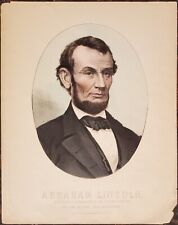
1865 President Abraham Lincoln Color 10x12 Pencil Etching Kimmel & Forster N.Y. $999.00
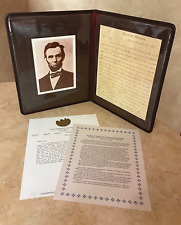
CIVIL WAR ABRAHAM LINCOLN LETTER TO FANNY McCULLOUGH FACSIMILE w/PORTFOLIO c1964 $299.00
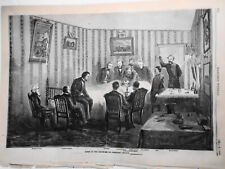
Scene At The Death-Bed of President Lincoln Harper's Weekly May 6, 1865 Original $115.00
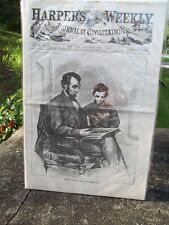
Harper's Weekly MAY, 6, 1865 President Lincoln's funeral $45.50
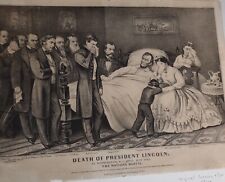
Abraham Death of President Lincoln Antique Currier & Ives Deathbed 4/15/1865 $150.00
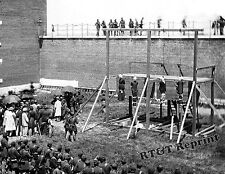
President Lincoln 1865 Civil War Assassination Hanging Photo $12.95
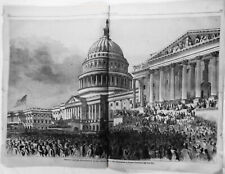
President Lincoln's Reinauguration at the Capitol March 4, 1865 - Original print $105.00
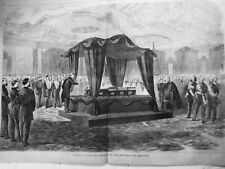
President Lincoln's Funeral, Service at White House Harper's Weekly, May 6, 1865 $85.00
|